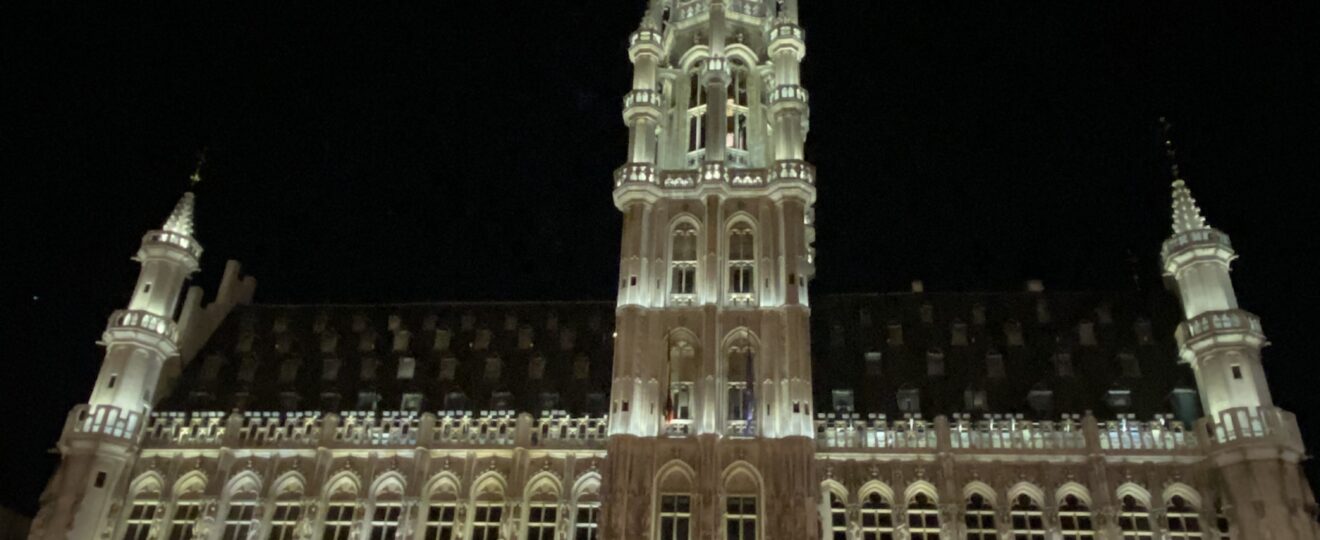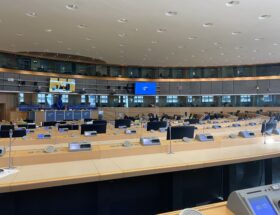‘We said we’d do it, so we did it: Galway ‘Capital of Culture’
The importance of the Arts and Culture sector was proven by the small city on the west coast of Ireland – Galway – after covid-19 interfered with their plans for the ‘Capital of Culture’ 2020 event.

Pictured – Marilyn Gaughan Reddan, Head of the Programme and Legacy. CREDIT // Sources LinkedIn Profile
By Daragh Ramage and Cliodhna Hogan
‘’The arts need to be highlighted more, it is how we promote ourselves across the world’’ says Marilyn Gaughan Reddan, Head of the Programme and Legacy.
Galway won the vote to host the 2020 ‘Capital of Culture’ event back in 2016 when there was no sign of a pandemic arising. The coronavirus then hit Ireland two days before the event was to begin, at the start of the year, resulting in an extension held virtually.
“It meant everything to Ireland and Galway to host this event as it was rising our cities profile…we had said we would do it, so we did it to ensure the artists and acts would not go unseen.’’ Marilyn said.
The event took place with 500 events, 600 artists and 31 local communities involved virtually. Marilyn stated, “This was the first event to continue despite the pandemic and have a successful outcome.’’
In previous years there are on average 70+ employees working on the ‘Capital of Culture’ event for their country, however, Galway started with 35 and had to cut it down to only 9 workers to operate under covid-19 restrictions.
Gaughan comments on the matter with, “The pandemic affected everyone in different ways, some people were made redundant and that then meant only 9 individuals had to work 16 to 17 hours per days for over a year.’’
The 9 hard working individuals that committed to this year-long project showed the importance for keeping the arts and culture sector alive, Marilyn stated how she was “grateful to have had the opportunity to create this event for others to enjoy.”
€15 million were funded by the Department of Arts, in the Irish Government, to allow this event and the projects to go ahead, which instead ended up being used to pay the artists. Marilyn speaks on the matter saying:
“We had signed contracts with each artist and company meaning we had to pay them, and we used this funding to do so, it meant a lot to them as they could continue their work and art.’’
She adds on that they ‘’won €1.5 million from the European Council and that was the only funding gained from them.’’ Which still meant a lot.
The European ‘Capital of Culture’ event highlights the richness and diversity of culture in Europe, whilst helping to raise the international profile of city regions; the title gives the city a long-term impact not only within culture but within social and economic terms.
‘Culture in Crisis: EU’s plan to support and boost the Culture and Creative Sectors post COVID-19 pandemic’
The Culture and Creative sectors (CCS) went into a massive decline after the COVID-19 pandemic first hit at the start of 2020, as live performances and exhibitions were amongst some of the first events to close and the last to reopen. Since then, the European Commission called on to include CCS in the recovery framework plan.

Pictured – Sonya Gospodinova, EU spokesperson for education, youth, sport, and culture. CREDIT // EU Commission ‘Spokespeople Contact Page’
By Daragh Ramage and Cliodhna Hogan
The pandemic’s economic effects have played an influential role on the EU’s decisions regarding the Multiannual Financial Framework (MFF) of 2021 to 2027’s division of funding, with additional funding being allocated to specific sectors.
“The Culture and Creative sectors are very important from various points of view, from our social environment to our European DNA”. says Sonya Gospodinova, EU spokesperson for education, youth, sport, and culture.
“The sectors are a very important part of our economy,” Sonya adds. “They (the sectors) represent 4.2% of the EU’s total GDP and 3.7% of the EU’s workforce.” That is a total of around 8.5 million people in the European Union working in the Culture and Creative sectors.
Sonya also comments about the importance of the sectors in relation to member states’ relationships. “We promote European integration. It promotes the development of regions and cross-cultural exchanges,” she said.
As of 2017-2018, Italy had the highest percentage of Creative Enterprises* in Europe with 15%, while France had the second-highest percentage of 12%. Creative Enterprises consist of entities that have origin in individual creativity, skill, and talent. Examples of these are visual arts, architecture, design, music, as well as cultural organizations such as museums and galleries. Meanwhile, the percentage of employment of individuals within the Culture and Creative sectors* in the European Union is the highest in the Netherlands, which consists of 4.8% of the population. Germany follows a close second with 4%. Employment in these sectors consists of people employed in museums/galleries, musicians, artists across a multi-media sector, film directors and producers, etc. The
*Figure comes from total data collected involving employment and Creative Enterprises throughout Europe. Important to note data collected is dated to pre-pandemic and pre-Brexit as of 01/02/20. Data collected from England is excluded from the chart.
Due to the pandemic, multiple events and gatherings within the sectors were forced to close due to physical COVID-19 restrictions throughout European member states. This resulted in a massive financial loss amongst businesses.
Sonya worryingly says, “We believe this impact will have lasting effects on the future”. She adds, “Cinema operators in the EU reported 70% drop-in box-office sales in 2020. Music venues reported a 76% drop in attendance and 64% in revenues. And museums have lost revenues of up to 75% – 80%.” Staggering figures.
Gospodinova also commented on how museums in some of the most popular EU regions that benefited from tourism prior to the pandemic suffered greatly. As she says, “The sectors have been hit hard, and that is why we are taking measures to support them and stimulate the growth of the sector.”
“It’s not only the pandemic that made member states realize (the importance of the Culture and Creative sectors), but also us.” She speaks.
Gospodinova goes on and mentions that “The sectors have always been a part of our EU policies. Especially since 2014, we have dedicated support. We have a fund, Creative Europe.”
The program aims to help fund and cover sections of the Culture and Creative sector. Since the launch of the program, they have given 13 thousand grants to different organizations and NGO’s and co-financed 647 different cultural corporation projects between 3,760 organizations across Europe.
“What is also very important is the training of professionals.” Sonya says, before telling us that, “16,000 professionals have received training through the program, as well as 5 thousand movies being funded by the program.”
Sonya said, “Following the pandemic, we have supported the Culture and Creative sectors through various measures such as state-aid. Funds for short-termed unemployed individuals in the Culture and Creative sectors.”
Sonya explains how people employed in museums, cinemas, and musical venues received unemployment payments from their national authorities. Going onto the latest MFF, Sonya had this to say:
“We have also ‘topped up’ the funding specifically to the sectors.”
The financial support for the sector has increased by almost €2.5 billion due to Creative Europe’s fund, and close to €2 billion from Horizon Europe, a program dedicated to research activities. This funding was dedicated to cultural, creative, and inclusive projects for the next financing period from 2021 to 2027.
Sonya says, “We also believe that more than 2% of the overall funding received by the Recovery Resilience funding will go towards the Culture and Creativity sectors.” That is a 2% total of the €700 billion involved in the Recovery Resilience Fund, which is to be used for the boost and recovery of the EU economy post-pandemic.
Creative Europe Programme
As stated by EC spokesperson, Sonya Gospodinova, the ‘Creative Europe invests actions that reinforce cultural diversity and respond to the needs and challenges of the culture and creative sector.’
Proven on the European Commission website, ‘The Creative Europe Programme’ for 2021-2027 has a budget of €2.44 billion compared to €1.47 billion of the previous program for 2014 to 2020. Safeguarding, developing, and promoting European cultural and linguistic diversity and heritage, whilst increasing the competitiveness and economic potential of the cultural and creative sectors, in particular, the audio-visuals sector is their main aim and objective for the next 6 years.
Due to the corona-virus pandemic, the novelties of the program will contribute to the recovery from covid in these sectors. By reinforcing their efforts to become more inclusive, more digital, and environmentally more sustainable. This is shown by dividing the C.E Programme into three strands: Culture, Media, and Cross-Sectoral strand. This helps the process for eligibility for funding and the application process for each EU-member state and non-EU country that have creative organizations in the process.
Since the 1st of January 2021, when the new C.E program (2021 to 2027) was introduced, several non-EU countries have expressed interest in participation, such as Iceland, Norway, Liechtenstein, Turkey, Lebanon, and many more. The interest and enthusiasm from non-EU countries to participate in Creative Europe empathize and proves the importance of the creative sector on a global scale, and how this new program helps the recovery process post-pandemic.
Video Link: https://www.youtube.com/watch?v=ecsgfEIbGiQ







